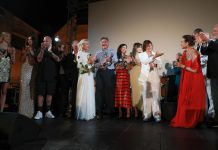Guide to the artistic sites Guide to the artistic sites
Aragonese Castle
The Aragonese Castle (Castello Aragonese, Ischia Ponte) was built on a rock near the island in 474 BC, by Hiero I of Syracuse. In 1441 Alfonso V of Aragon connected the rock to the island with a stone bridge instead of the prior wood bridge, and fortified the walls in order to defend the inhabitants against the raids of pirates. Around 1700, about 2000 families lived on the islet. There were also thirteen churches. In 1912, the Castle was sold to a private owner. Today the castle is the most visited monument of the island.
In the Castello Aragonese there is a small chapel consecrated to Saint John Joseph of the Cross (San Giovan Giuseppe della Croce), the patron saint of the island. Besides, it is possible to visit the Church of the Immacolata and the Cathedral of Assunta.
Villa Arbusto
Villa Arbusto is situated in the picturesque town of Lacco Ameno, close to Santa Restituta Square.
The land was originally purchased in 1785 by Don Carlo Acquaviva, the Duke of Atri, who had the villa built. In 1952 it was then purchased by film producer Angelo Rizzoli, who restored to villa to its ancient glory and landscaped spectacular gardens with rare plants originating from all over the world; standing out among the species is the colletia cruciata with unusual branches with flat thorns and small white flowers, and the jacaranda, considered amongst the 10 most beautiful flowering plants in the world.
The villa, boasting a superb setting overlooking the sea, is today open to the public and also hosts numerous exhibitions, events and concerts especially in summer.
Part of the villa is also small museum, Museo di Pithecusae (the original name of the island), with archaeological finds such as the famous Nestor’s cup, dating back to the 8th century B.C.
Villa La Colombaia
Villa La Colombaia is located in Lacco Ameno and Forio territories. Surrounded by a park, the villa (called “The Dovecote”) was made by Luigi Patalano, a famous local socialist and journalist. It is now the seat of a cultural institution and museum dedicated to Luchino Visconti.
Churches
The artistic and cultural heritage- of the island of Ischia is valued, among other things, by the numerous churches that in different ages have been built with different architectural styles. These buildings are present on the territory with humble discretion, other times rise imperious or gather together in a varied mix creating small agglomerates often behind houses and domes, changing the different very characteristic centres of the island.
The wineries
The ancient wine cellars, that are lots of on the island, represent a real rich cultural and historical background, in the municapility of Barano and Serrara Fontana (as well in other locations) are dug into the rock into wide caves, dark, fresh and full of numerous utensils to the homemade wine-making.
Some of these are vey old, about hundred years and are part of the family background for many generations.
The Houses of Stones
The island outback has got a country culture that, as far as modern, is based on ancient origins. The experts interested in our island, are fascinated by some rural settlements and them primitive architecture, particularly the south-side: from Serrara Fontana to the streets of Cuotto, Ciglio, Monterone that go on to Forio.
These settlements are known as ‘stone houses’. Explaining the story, even if full of blancks, it’s necessary to consider some geological characteristics of the island but who wants more fantastic explanation about the presence of them, can refer to the classical mythology. In order to satisfy who believe in science, we inform that maybe in the second century A.D., because of a series of earthquakes that changed the morphology of the territory, big stones of lavic rock went down the downhill, particularly towards S.Angelo, Punta Imperatore, Citara and another side called Falanga.











